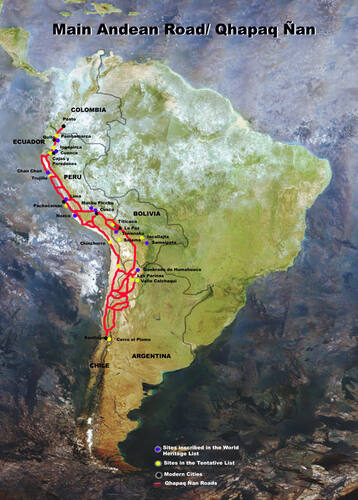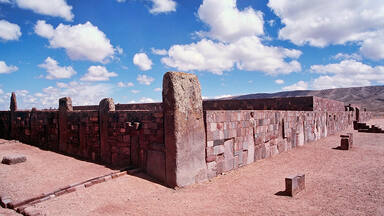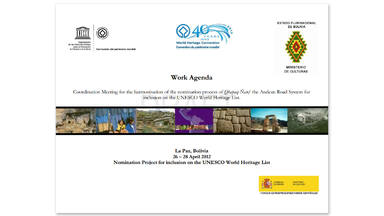Main Andean Road - Qhapaq Ñan
Argentina, Bolivia, Chile, Colombia, Ecuador and Peru share a common cultural heritage of outstanding value: the Qhapaq Ñan, or Main Andean Road.
For the past three years the World Heritage Centre has been assisting these countries in a pioneering project: the preparation of a single nomination for the inclusion of Qhapaq Ñan in the World Heritage List entailing an original and innovative regional cooperation process.
Description
Qhapaq Ñan otherwise know as the Main Andean Road, was the backbone of the Inca Empire’s political and economic power. The whole network of roads over 23,000 km in length connected various production, administrative and ceremonial centres constructed over more than 2,000 years of pre-Inca Andean culture
The Main axis of the route, also known as the Royal Road runs along the peaks of the Andes which is at it's most discernable between Quito and Mendoza. In addition to this backbone over the highest peaks, other roads also run in a north-south direction along the Pacific coast. The Inca Empire organized its network on a continent-wide scale; its roads are an invaluable expression of the organizing and planning spirit of the available labour force and constituted a key instrument in unifying the Empire physically and organizationally.
This route is a demonstration of universal value on a grand scale. Experts' meetings have been held to identify the cultural significance and unitary value of the entire network with a view to considering options for its inclusion on the World Heritage list through various forms of technical cooperation.
The Incas of Cuzco achieved this unique infrastructure with a unitary character in less than a century, making it functionally coherent and establishing additional centres for commerce, exchange, production and worship, adapting production sectors to topography and climate, in each ecological area to be found along the Road. The Road also expressed these peoples’ harmonious relation with and their adaptation to the complex Andean natural setting. Today, the cultural landscapes of Qhapaq Ñan form an exceptional backdrop on which living Andean cultures continue to convey a universal message: the human ability to turn one of the harshest geographical contexts of the American continent into an environment for life.
Background – Nomination process
In May 2001, Peru took the initiative of including the Qhapaq Ñan on its Tentative List. The governments of Argentina and Chile subsequently joined the initiative. In March 2002, during the first meeting on World Heritage Periodic Reporting, the focal points of Argentina, Bolivia, Chile, Ecuador and Peru drafted the document “Pre-Hispanic Andean roads and the routes of Tahuantisuyo”, which summarized their proposals for further advancing the initiative.
On 29 January 2003, at UNESCO Headquarters in Paris, the Permanent Delegates of the Andean countries requested the World Heritage Centre by common consent to take charge of the overall coordination of the project and to assist in the nomination procedure. This coordination framework constituted of a methodological orientations for devising the inclusion procedure for a site common to six States Parties to the World Heritage Convention, the first of its kind in the experience of the World Heritage Centre’s Latin America and Caribbean Unit.
Following these meetings, 7 further technical meetings were held in Cusco (Peru), Paris (France ), La Paz (Bolivia), Santiago (Chile), Quito (Ecuador), Buenos Aires (Argentina) and Pasto (Colombia). These meetings created the groundwork, involving decision makers as well as stakeholders in the process of this ambitious nomination. In addition to this, two Scientific Committee meetings were held to facilitate the thematic development of the nomination. In October 2006 a meeting of legal experts met in Paris to discuss the legal and juridical implications and requirements that such a nomination requires.
The nomination process reflects the conceptualization and development of a participatory methodology necessitating the involvement the living culture along the Main Andean road.
The following successes can be observed:
- The involvement of over 300 participants in 6 different countries
- The surveying of over 15.000km of roads
- 6 national multi-disciplinary teams
- The creation of thematic and typographic registration forms to inventory pertinent sites linked to the road
- The inclusion of the importance of oral history in the conception of the future nomination
- The collaboration of 20 strong group of the world-renowned experts in the area of the Qhapaq Ñan
- The conception and construction of a juridical instrument to ensure the proper construction and management of the Qhapaq Ñan at an international level




